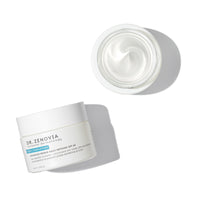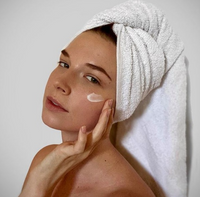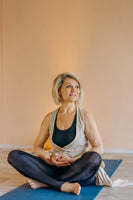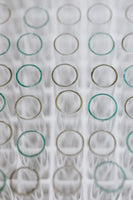Rosacea: Symptoms, Causes, and Top Treatments

Rosacea is a recurring inflammatory skin condition that affects both men and women. The main areas of the face that are affected are the nose, cheeks and chin area. Rosacea can have a genetic component making it more likely to run in families. This skin condition commonly occurs in people between the ages of 30-50 with fair skin. Previously branded as “Irish Acne”, rosacea was given this name because it often appears on people of northern or eastern European descent with light-colored skin.
Rosacea classically presents flushed cheeks, tiny visible blood vessels, and pimples and pustules. This skin condition causes a weakened skin barrier resulting in rosacea flare-ups that affects people by increasing sensitivity and irritation on the skin as well as lowering one's self-confidence and self-esteem. The appearance and severity of rosacea can vary vastly from person to person which is why it is essential to understand the types and symptoms.
Rosacea: Types and Symptoms
There are four types of rosacea:
Erythematotelangiectatic Rosacea: This type of rosacea results in visible blood vessels (telangiectasia) appearing on the skin. Additional symptoms include flushing and persistent redness, sensitivity, and a sense of heat or a burning sensation accompanied also by dry, flaky skin.
Ocular Rosacea: This type of Rosacea affects your eyeballs (yes, your eyeballs!) It results in blood shot, watery eyes with a feeling of grittiness, a stinging sensation, and dry, itchy, and irritated eyes. Those with ocular rosacea can also have a higher sensitivity to light.
Papulopustular Rosacea: This type of rosacea is more severe and results in bumps, pimples and pustules showing up on your skin. Symptoms include oily skin, sensitivity, acne-like pimples, and raised patches on the cheeks, forehead, and chin.
Rhinophyma Rosacea: Most commonly seen in older men, this type of Rosacea mainly affects the nose. It can even cause the nose to change shape due to the sebaceous gland thickening. This is a result of the oil glands being so enlarged that it begins to alter the form of the tissue. This type of Rosacea can also thicken the skin of the chin, forehead, cheeks, and ears, creating a bumpy, cratered texture.
Perioral Dermatitis: A cousin of rosacea, this condition is very common and difficult to treat. Perioral dermatitis occurs when you get sensitive rashes around your mouth or nostrils. Many people think it is a consequence of rosacea, however, it is a very important distinguishing feature that separates it from traditional forms of rosacea. It is often times resistant to treatment and comes in waves.
Rosacea Causes
The exact cause of rosacea is still unknown however, the best way to describe what is happening, is to think of it as inflammation of the oil glands which are concentrated on the nose, cheek, and chin. This inflammation at the sebaceous gland level causes vasodilation (which means the blood vessels are dilated) so visible cords of blood vessels or superficial redness from the blood flow appear prominent at the surface. Think of it like the “arthritis” of the oil gland.
The second component is skin barrier disruption. The epidermis acts as a fierce barrier to the outside world and the top layer called, the stratum corneum, is essential. When our skin is inflamed, that important barrier is broken down. As a result of a compromised skin barrier, people experience flakiness, dryness and sensitivity in the skin. Many people with rosacea state that every cream or topical product causes irritation or a stinging sensation. In summary the common features of rosacea include oil secretion, barrier disruption, and vasodilation. This is a multi-factorial problem and one must address all features to see improvement.
Rosacea Treatment
Topical prescription medication is first-line for rosacea and can be highly effective. The next step in therapy is oral antibiotics like doxycycline and other tetracyclines. These antibiotics are used long-term; and they have potent anti-inflammatory properties that can significantly improve rosacea and perioral dermatitis. Laser therapies, like ones that target blood vessels, are also great for telangiectatic rosacea because if you eliminate the blood vessel bed you can improve the overall condition.
Rosacea Treatments
There is no known cure for rosacea but there is way to help reduce flares.
Moisturize: Moisturization is an absolute must as it helps to not only protect but restore the skin barrier. It also helps keep irritants off the skin. Dr. Zenovia's Peptide + Ceramide Repairing Moisturizer is ideal for even the most sensitive skin. Free of alcohol and fragrance, this unique combination of bio-equivalent ceramides, potent humectants, and emollients helps attract, retain, and distribute moisture to fortify the skin's protective barrier and combat dryness for a glowing, radiant complexion.
Be Gentle: If you have acne prone skin and are experiencing rosacea flare-ups you should not use traditional acne products (like benzoyl peroxide or retinols) on because it can worsen irritation. Make sure the topicals you use are oil-free and water based. Dr. Zenovia also recommends limiting the use of products that contain alcohol, witch-hazel, and exfoliants – all these can inflame the skin and worsen rosacea.
Be Careful With Certain Foods/Drinks: Certain foods and drinks can act as a trigger for rosacea. Spicy food, alcohol, and hot beverages can increase vasodilation and therefore potentiate rosacea flares.
Avoid Extreme Temps: Any forms of extreme hot, cold, dry, or windy weather can affect rosacea because the harsh conditions affect your skin.
De-Stress: Stress is well-known trigger for acne and rosacea. With rosacea, lowering your stress levels can help reduce rosacea flare-ups.
Avoid Direct Sunlight: UV radiation is a well-known trigger for rosacea and SPF it is the most important therapeutic intervention. Always use a mineral sunscreen (zinc/titanium) every single day - not just when you plan on being in the sun for outdoor activities. Chemical sunscreens are more likely to irritate your skin.
Rosacea affects millions of Americans and people around the world. It is one of the most common and frustrating skin disorders with their multiple treatment modalities. Although there is no cure, Rosacea can be controlled and minimized with the proper symptom-targeted skin care.









Leave a comment